Radical Aircraft Nuclear Propulsion Concepts
NEPA and polonium-powered aircraft
At its sixth board of consultants meeting in January 1949, the Oak Ridge-based Nuclear Energy for the Propulsion of Aircraft (NEPA) project technical committee discussed an intriguing idea concerning a possible exotic form of nuclear powerplant for aircraft.
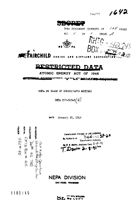 |
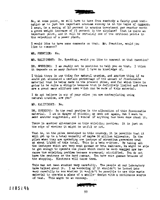 |
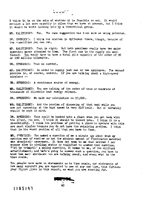 |
(click to enlarge)
HREX |
NEPA had been in operation since the Spring of 1946, and was studying a baseline nuclear propulsion system for an enormous, turbojet bomber of nearly unlimited endurance, capable of carrying a heavy nuclear weapon load at speeds of over 500 mph. The powerplant would have comprised an air-cooled reactor of about 50 megawatts thermal output linked to four large modified turbojet engines. The whole assembly would have been mounted in the aft fuselage of a B-36-derived aircraft, and massive amounts of lead, steel, water and other types of shielding would have been required to protect the crew from the intense neutron and gamma radiation emitted by the operating reactor.
This cumbersome radiation shielding was acceptable in ship and submarine applications, but putting so much dead weight in an aircraft was a horror to aeronautical designers who ordinarily strive to banish it. Many creative solutions to the shielding problem were proposed during the course of the NEPA and ANP projects, but there was no magical way to get around the need for tons of some form of dense material between the reactor and cockpit if the crew was to survive a mission.
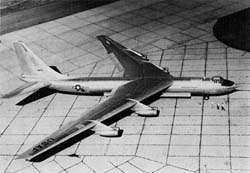 |
The colossal Convair YB-60 was representative of the size of a typical nuclear-powered aircraft based on early NEPA research. The X-6 would have been a modified version of this aircraft equipped with a General Electric P-1 50 megawatt air-cycle reactor/turbojet plant. NEPA believed that a polonium-powered aircraft could have been drastically smaller |
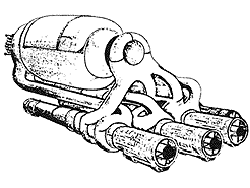 |
The P-1 air-cycle reactor complex for the X-6 was a nightmare of ducting. Air from the engine compressors would pass through the reactor to be heated and returned to the engine turbines. The mass of the assembly, probably around fifty tons, was such that only the largest airplanes could possibly carry it. A radioisotope engine as envisioned by NEPA in the late 1940s probably would have followed this basic layout, but on a much smaller scale See: NEPA |
At the January 1949 NEPA meeting, however, an interesting idea was raised by consultant Dr Frank H. Spedding of the Iowa State College Institute for Atomic Research. (Spedding had helped produce the uranium used in Enrico Fermi's original nuclear pile at the University of Chicago in 1942 and was an authority on rare-earth elements). Spedding pointed out that a small portion of the fission products from nuclear reactors are thermally hot radioisotopes, such as strontium-90, which are comparatively weak emitters of gamma and neutron radiation, the most penetrating radiation that requires the heaviest shielding. By separating these types of isotopes from the output of production reactors, enough material could theoretically be collected to assemble an intense heat source that could replace the combustion chambers of an ordinary jet engine, enabling the heat of radioactive decay (rather than energy from the fission chain reaction of a nuclear reactor) to power an aircraft. The huge advantage would be that the mass and size of the reactor could be greatly reduced for a given power output, which would also permit the aircraft itself to be much smaller and more efficient (a powerplant of this type would not have been so much a "reactor" as an assembly of hot fuel units).
Andrew Kalitinsky, an official of Fairchild Aircraft, the NEPA prime contractor, acknowledged that consideration already had been given to use of polonium fuel (emitting alpha particles, composed of two protons and two neutrons) for these reasons. Alpha particles are massive and are readily stopped by thin layers of metal or other materials. But he noted two major problems, among others -- polonium-210 was so rare that the entire US reactor infrastructure could only produce enough of it to supply one or two aircraft; and the high-energy polonium reaction would continually generate much more heat than the engines could use under most flight conditions, creating the need to dispose of tremendous amounts of waste energy. When the plane was on the ground, for example, it would have to be linked to a cooling system to keep the engine from catastrophically overheating.
To give some idea of the implications of this type of system, consider that a NASA primer on radioisotope power sources states that freshly irradiated polonium has a specific power output of 141 watts per gram. According to a Los Alamos reference on the element, the energy released by its decay is so large that a capsule containing about half a gram reaches a temperature above 500 degrees C (930 F). If this could be used with 100 percent efficiency, NEPA's 50 megawatt bomber engine would only need about 775 pounds of polonium-210 fuel, with almost none of the reactor's shielding (given polonium's density, this would be equivalent to the volume of a rod about three feet long and nine inches in diameter). Smaller aircraft would need proportionately less fuel.
On the other hand, polonium was produced with difficulty only in quantities of thousandths of a gram, is extremely toxic to humans, and its alpha-radiation field is phenomenally intense. In the words of one report (The Radiochemistry of Polonium, by P. E. Figgins, Mound Laboratory), "the intense radiation of curie-level samples causes a fluorescence in the surrounding gas and in glass or silica containers. In the dark a quite spectacular blue-white glow is observed from curie-level metallic samples..." The constant bombardment of alpha particles damaged any materials in contact with the polonium, crazing glass, degrading organic compounds and making metal brittle.
At the time, polonium-210 was processed at a highly-sensitive complex of facilities operated by the Monsanto corporation in and near Dayton, Ohio. According to a Top Secret Army document dated 29 December 1947, four "Vital Installations" existed in the US that were considered to be of the highest defense priority:
1. The plutonium production and processing facilities at Hanford, Washington;
2. Los Alamos, New Mexico and Sandia Base;
3. The uranium gaseous diffusion plant at Oak Ridge, Tennessee;
4. Monsanto Units 3, 4, and 5, Dayton, Ohio
Monsanto's Dayton plants and Mound Laboratory produced polonium-210 for use in the supersecret "urchin" or "screwball" -- the "initiator" that emitted the burst of neutrons that launched the chain reaction in the early US fission bombs.
See: Monsanto's Dayton Works and Polonium Processing
See: Carey Sublette's Nuclear Weapons FAQ
Mound Laboratory would later participate in research on polonium-based radioisotope thermoelectric generators (RTGs) for interplanetary spacecraft. The NEPA studies of radioisotope heat sources apparently are some of the earliest forays into what would become an important field of space power generation technology.
See: DOE history of RTG development
It's difficult to tell how seriously the exotic idea of polonium-210, strontium-90 or actinium-powered aircraft was pursued in the late 1940s. Most likely it was not pushed with enthusiasm, due to the very real production and cost issues (not to mention safety considerations in event of a crash). However, there were specialized aircraft applications that provoked spikes of interest in this technology from time to time.
Project BEACON HILL was a classified Air Force study, conducted at MIT from mid 1951 to mid 1952, which examined possible methods of carrying out covert, "pre-hostilities" air reconnaissance of the USSR. The study examined technologies such as satellites, balloon-borne cameras, modified cruise missiles with camera packages instead of warheads, and radical new types of aircraft. One of the main technical challenges was that to be covert, a specialized reconnaissance plane would have to be as small as possible, but it seemed impossible to design a small aircraft with sufficient range to cover the tremendous area of the USSR.
According to reconnaissance historian Dwayne Day, the BEACON HILL analysts brought up the polonium-210 engine as a possible "silver-bullet"-style solution to this special problem. It's an intriguing thought: a compact plane powered by nuclear energy, able to fly for nearly unlimited distances at any altitude and speed. But once again, the practical problems of polonium supply and handling intruded and the idea was shelved. (Ultimately BEACON HILL backed development of the Project GOPHER reconnaissance balloons due to their low cost, and within two to three years, improvements in conventional jet engine technology allowed designers to develop a small, strategic-range aircraft called the U-2 to perform the mission BEACON HILL had envisioned).
Several documents from the Project SIGN era of Air Force UFO research, which began about two years after NEPA's creation, refer to exotic, advanced types of compact nuclear engines as possible power sources for the flying saucer, assuming they were advanced man-made vehicles. It seems likely that radioisotope engines were possible candidates.
See: Col C D Gasser and Project SIGN
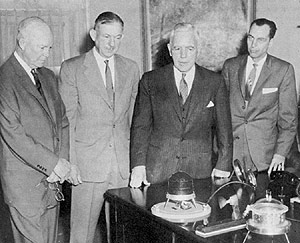 |
Polonium on the president's desk. Dwight Eisenhower contemplates System for Nuclear Auxiliary Power-3, a four-pound, 5-inch-diameter radioisotope nuclear generator powered by .38 grams of polonium-210, during a White House demonstration on January 16, 1959. SNAP-3 used thermocouples to extract 3.3 watts of electricity at 2.5 volts from the 500 degree C heat produced by the decay of polonium contained in two tiny stainless-steel capsules inside the dark container. Aircraft Nuclear Propulsion program chief Maj General Donald Keirn stands between Eisenhower and Atomic Energy Commission head John McCone. SNAP-3 is powering a tiny electric motor attached to a whirling propeller just below McCone's left hand |
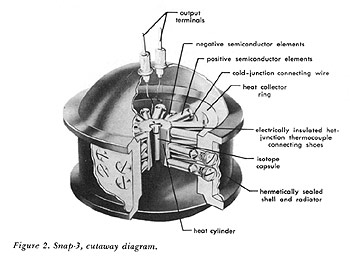 |
SNAP-3 internal components. It was one of the first in a long line of nuclear-electric generators for space vehicles and other specialized applications |
The concept lived on into at least the 1960s or '70s. Veteran CIA intelligence analyst Allen Thomson recalls that
Back in 1978 I actually saw a mock-up of such an engine that had been designed earlier to power a long-duration SIGINT drone. It was a cylinder perhaps a meter long by 25 cm in diameter with a belt of [polonium] tablets on the outside. [If I recall correctly], it was a Brayton or Rankine cycle engine driving a propeller. The baseline mission was to fly into the USSR and cruise between microwave towers slurping up signals, the Sary Shagan [antiballistic missile] test range being the initial point of interest. The concept died because of the difficulties involved with producing and handling polonium, plus what would happen if one of the things crashed and people found the tablets (not good for the people). Also, other ways were found to get the desired information.
The General Atomics company, founded by physicist Frederick De Hoffman, quietly developed a number of extremely advanced nuclear propulsion concepts in the 1960s and may have been the contractor for this ultra-exotic reconnaissance drone.
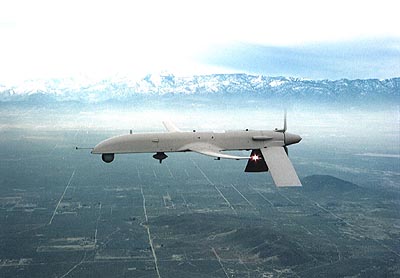 |
General Atomics GNAT UAV |
Polonium and Stealth
An even more unusual application of radioisotopes like polonium has come to light. In 1964, a North American Aircraft employee named Henry August filed an application for a patent for a very strange method of reducing the radar cross-section of an aircraft. The patent describes a method of applying a thin layer of radioisotope, such as polonium-210, to the surface of an aircraft with the intention of ionizing the air around the vehicle. This ionized sheath would absorb incoming electromagnetic waves, such as radar pulses, as well as reduce the infrared signature of the craft. In addition, August claimed that by proper use of electromagnetic fields, the ionized region around the vehicle could be manipulated to reduce air drag and control air flow!
Whether such a remarkable idea was ever tried outside the laboratory, given the obvious drawbacks of polonium, is a question that remains to be answered.